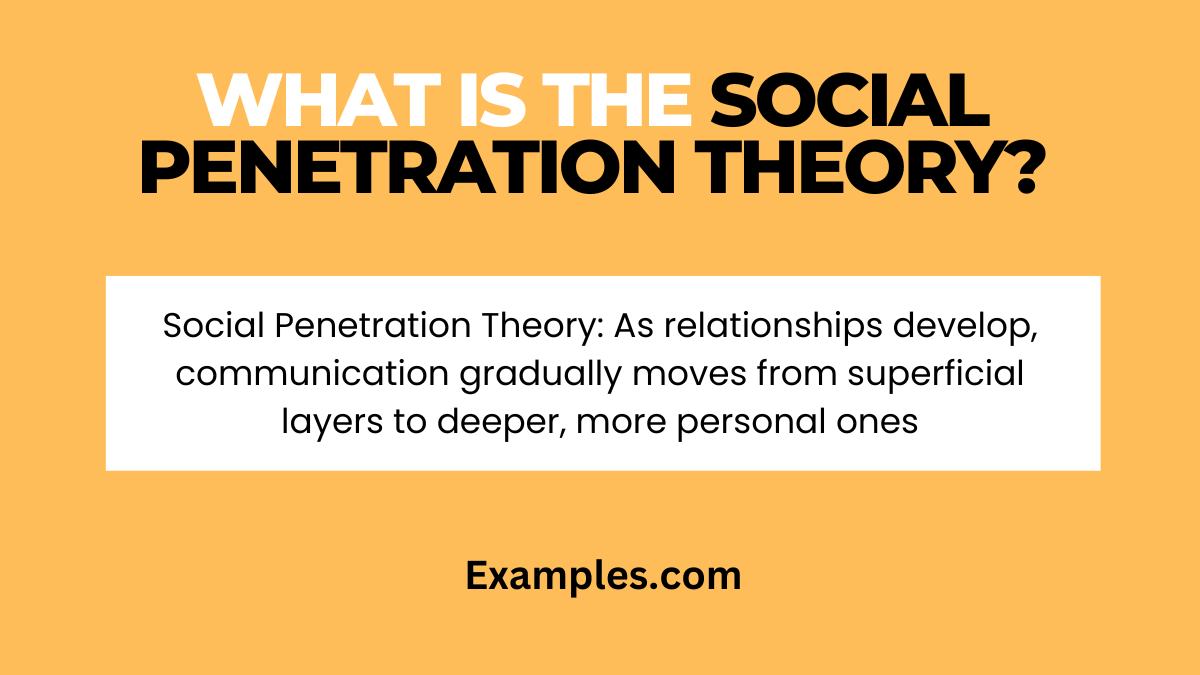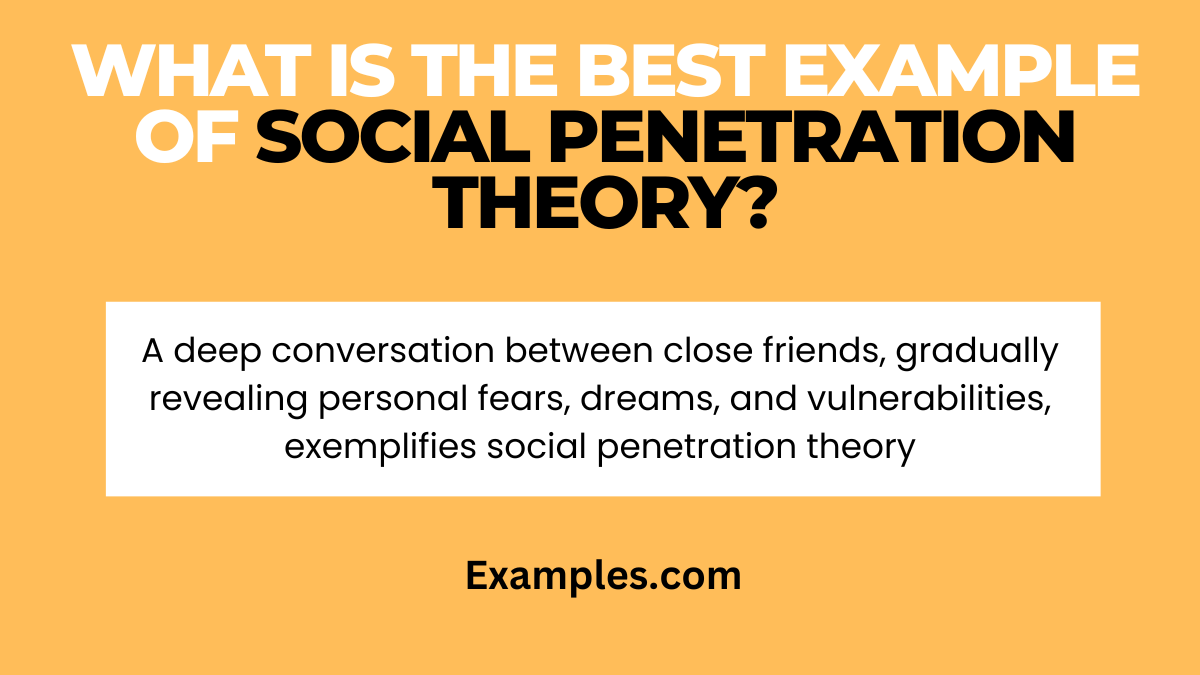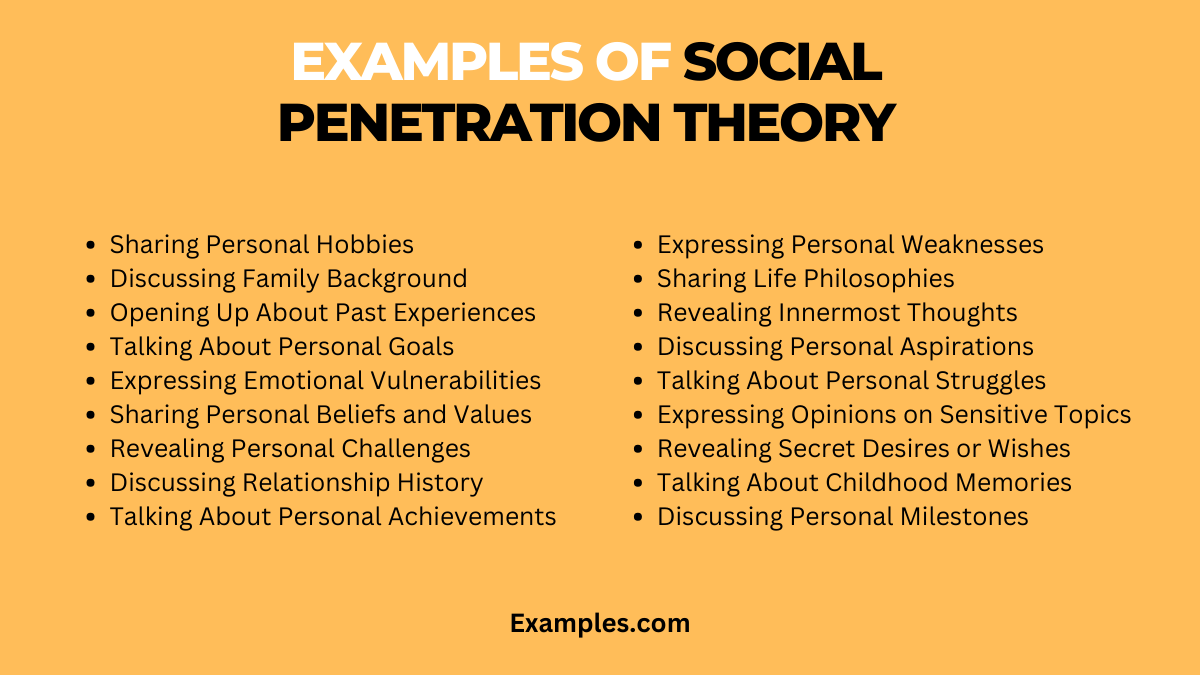20 Social Penetration Theory Examples
Social Penetration Theory delves into the layers of interpersonal communication, revealing how relationships progress from superficial exchanges to deeper, more meaningful interactions. This comprehensive guide illuminates the intricacies of the theory, offering practical insights on how to apply these concepts in everyday life. By understanding the gradual process of self-disclosure and the dynamics of vulnerability and trust, you can navigate your social interactions more effectively, fostering stronger, more authentic connections.
What is the Social Penetration Theory?

Social Penetration Theory, conceptualized by psychologists Irwin Altman and Dalmas Taylor, illustrates how interpersonal relationships develop. It suggests that communication evolves from shallow, non-intimate levels to deeper, more personal ones. This theory is fundamental in understanding how bonds form and strengthen over time through gradual and reciprocal sharing of personal information.
History
Who Created: Irwin Altman and Dalmas Taylor
Date: 1973
Their work is encapsulated in the book “Social Penetration: The Development of Interpersonal Relationships.” This theory was a pioneering effort to understand the dynamics of how relationships progress from superficial levels to deeper, more intimate ones.
What is the Best Example of Social Penetration Theory?

The best example of Social Penetration Theory can be observed in the development of close friendships or romantic relationships. Initially, conversations are surface-level, discussing general topics like hobbies or the weather. As comfort and trust build, exchanges become more personal, delving into beliefs, fears, and aspirations, symbolizing deeper layers of personality and intimacy
20 Examples of Social Penetration Theory

Social Penetration Theory explores how relationships progress from superficial to intimate levels through communication. It emphasizes the role of self-disclosure in deepening connections. This theory is crucial in understanding various aspects of intrapersonal and interpersonal communication. Here are 20 unique examples, each explained in two sentences with a communication example:
- Sharing Personal Hobbies: When two colleagues talk about their personal hobbies, it demonstrates a move from surface-level topics to more personal ones.
Example: “I love gardening. Do you have any hobbies you’re passionate about?” - Discussing Family Background: In a new friendship, discussing family backgrounds indicates a deeper level of trust and understanding.
Example: “I grew up in a large family. What was your family like?” - Opening Up About Past Experiences: Sharing past experiences, especially challenging ones, signifies a deeper level of intimacy in a relationship.
Example: “I had a tough time during my college years. Have you ever faced something similar?” - Talking About Personal Goals: When individuals discuss their personal goals and aspirations, it shows a willingness to open up and connect on a deeper level.
Example: “I aspire to start my own business someday. What are your dreams?” - Expressing Emotional Vulnerabilities: Expressing fears, insecurities, or emotional struggles is a significant step in deepening a relationship.
Example: “I often worry about failing. Do you have any fears?” - Sharing Personal Beliefs and Values: Discussing personal beliefs and values indicates a deeper level of understanding and acceptance.
Example: “I strongly believe in giving back to the community. What values are important to you?” - Revealing Personal Challenges: Talking about personal challenges or hardships shows trust and a deepening of the relational bond.
Example: “I’ve been dealing with some health issues lately. Have you ever faced health challenges?” - Discussing Relationship History: Sharing details about past relationships can signify trust and a desire for deeper connection.
Example: “I’ve learned a lot from my past relationships. What has been your experience?” - Opening Up About Fears and Anxieties: Sharing fears or anxieties indicates a level of comfort and intimacy in the relationship.
Example: “I get anxious before presentations. Do you experience anxiety?” - Talking About Personal Achievements: Discussing personal achievements allows individuals to share their pride and joy, deepening the connection.
Example: “I recently got a promotion at work. Have you had any recent achievements?” - Expressing Personal Weaknesses: Admitting weaknesses or areas of improvement shows vulnerability and trust.
Example: “I struggle with time management. What are your weaknesses?” - Sharing Life Philosophies: Discussing personal life philosophies indicates a deep level of intellectual intimacy.
Example: “I believe that everything happens for a reason. What’s your life philosophy?” - Revealing Innermost Thoughts: Sharing innermost thoughts and feelings is a clear indicator of deep social penetration.
Example: “Sometimes, I feel overwhelmed by expectations. Do you ever feel the same?” - Discussing Personal Aspirations: Talking about where one sees themselves in the future reveals hopes and dreams.
Example: “I dream of traveling the world. What are your aspirations?” - Sharing Emotional Responses to Past Events: Discussing how past events emotionally affected one shows emotional openness.
Example: “The loss of my pet deeply affected me. Have you experienced a loss?” - Talking About Personal Struggles: Sharing struggles like anxiety or depression indicates a significant level of trust.
Example: “I’ve been coping with anxiety. Do you have any personal struggles?” - Expressing Opinions on Sensitive Topics: Sharing opinions on controversial or sensitive topics can deepen understanding.
Example: “I have strong opinions about environmental issues. What are your thoughts?” - Revealing Secret Desires or Wishes: Discussing hidden desires or wishes shows a deep level of personal trust.
Example: “I’ve always wished to write a book. Do you have a secret wish?” - Talking About Childhood Memories: Sharing childhood memories can create a strong emotional bond. Example: “I had a very adventurous childhood. How was your childhood?”
- Discussing Personal Milestones: Talking about significant personal milestones indicates a willingness to share personal journeys.
Example: “Graduating was a huge milestone for me. What milestones have you achieved?”
Stages of Social Penetration Theory
The Social Penetration Theory consists of distinct stages that describe the development and deepening of interpersonal relationships.
- Orientation Stage: Conversations are superficial and follow social norms.
- Exploratory Affective Stage: Disclosure increases, with talks about personal interests.
- Affective Stage: Deeper emotional exchanges occur, with personal and private matters shared.
- Stable Stage: Individuals fully understand each other’s personalities and communication becomes highly personal.
- Depenetration: This occurs when one or both individuals retract from the relationship, reducing intimacy.
Factors Influencing Social Penetration Theory
Several factors influence the progression of Social Penetration Theory in relationships:
- Personality: An individual’s personality affects how quickly and deeply they self-disclose.
- Relationship Rewards and Costs: The perceived benefits and drawbacks of a relationship guide its depth.
- Situational Context: The setting and circumstances of interactions affect relational development.
- Cultural Norms: Different cultures have varying norms for self-disclosure and intimacy.
- Social Exchange: The give-and-take dynamic in relationships influences their progression.
What are the Limitations of Social Penetration Theory?
Despite its widespread application, Social Penetration Theory has limitations:
- Over-Simplification: The theory oversimplifies complex human interactions and relationships.
- Cultural Bias: Developed from a Western perspective, it may not apply universally across cultures.
- Neglect of Individual Differences: It overlooks the impact of personal characteristics on relationship development.
- Linear Progression Assumption: Assumes that relationships always progress linearly, which isn’t always true.
- Lack of Emphasis on External Factors: External influences on relationships are not adequately addressed.
What are the Assumptions of Social Penetration Theory?
The theory operates on several key assumptions:
- Relational Development is Systematic and Predictable: Relationships progress in a linear and predictable fashion.
- Self-Disclosure is Core to Relationship Development: Sharing personal information is fundamental to deepen relationships.
- Relational Development Involves De-layering: Moving from superficial to more intimate layers of communication.
- Reciprocity is Key in Early Stages: Early stages of relationships often involve a mutual exchange of information.
- Penetration is Gradual: Relationship development is a gradual process of layer-by-layer revelation.
The Social Penetration Theory is essential for effective communication. This guide has provided valuable insights into the theory’s application. By gradually revealing layers of information in interpersonal relationships, we build trust and deepen connections. To apply this theory effectively, remember to balance self-disclosure and reciprocity, creating meaningful and lasting bonds with others through open and honest communication.



